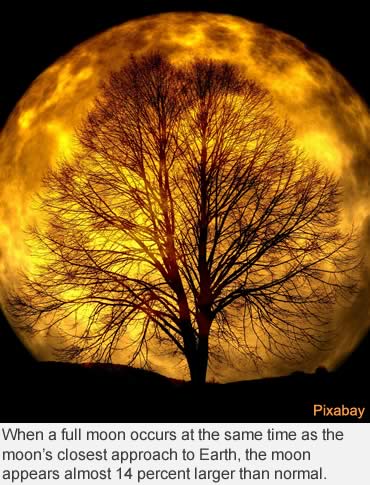During September when days and nights begin to cool, we look to the night sky to see a brilliant Harvest Moon, the full moon that occurs nearest the autumnal equinox. It’s the moon that gives off the most light at a time when bringing in a harvest takes longer than a full day.
The brilliant moonlight—if the weather is not too cloudy—is bright enough to give those who harvest crops enough extra light for bringing in grain or other crops.
But . . . wait a minute.
Because the autumnal equinox occurs September 22 in 2017, that means the next full moon will be October 5, and that’s the full moon identified as the Hunter’s Moon, a time when Native American hunters prepared for the coming months by hunting to increase their winter food supply.
In 2017, the Farmer’s Almanac, identifies the September full moon as the Corn Moon, but that name is close enough to be the Harvest Moon which it then moves to October.
It can get confusing because the custom to name moons comes from more than one source in human history and folklore. Moon names originate from the time before modern agriculture, the advent of electricity and combustion engines.
The first settlers in the Americas had one group of names for their calendar of full moons, and different Native American tribes used different names for full moons as did those in Celtic and Chinese cultures.
When the autumnal equinox marks the end of summer and the beginning of fall, the sun appears to cross the celestial equator, dividing the earth’s hemispheres into night and day with equal portions of 12 hours of light and darkness.
 It’ll happen again in the spring during the vernal equinox, when daylight and night are equally divided on March 12, 2018.
It’ll happen again in the spring during the vernal equinox, when daylight and night are equally divided on March 12, 2018.
The tilt of the earth's axis is what creates seasons in the earth’s hemispheres. During equinoxes in March and September, the earth is closest to the sun. In March, the Northern Hemisphere is tilted toward the sun and experiences summer. In September, it’s the Southern Hemisphere’s turn at summer.
In short, equinox is when the sun is directly over the equator, and solstice occurs at the lowest and highest points of the sun in the sky.
Identifying the date of the next full moon is as close as finding a calendar with moon phases indicated. But a lunar calendar is a bit different than the calendar on the wall. A lunar (or synodic) month is measured between successive new moons which takes about 29 1/2 days, specifically 29.531 days.
It takes the moon only 27.3 days (called the sidereal month) to complete its orbit around the earth, but in the earth’s motion around the sun it will not complete a full cycle until it reaches the point in its orbit where the sun is in the same position.
The two-day difference is because it takes the earth longer to revolve around the sun than the moon to revolve around the earth.
When a full moon occurs at or during the same time as the moon’s closest approach to Earth, the moon will appear up to 14 percent larger than normal. Sometimes this is called a supermoon.
In 2017, that full moon, known as the Full Cold Moon, will occur December 3. Winter solstice, the shortest day of the year, occurs December 21, which is also known as the first day of winter.
For more information about moon phases and dates and times of full moons, visit here.
To learn more about what’s in the sky above, click here.